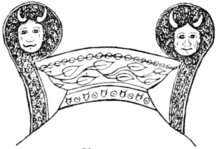and not for Pan. Apart from that peculiarity, I would again point to the remarkable expression of distress or agony (so unlike the Jovial Pan), so evident upon three of them and on the Pompeian bronzes, upon which I have sufficiently remarked elsewhere.[1] It should be remembered that these horned terra-cottas were found at Taranto, in Apulia, and it is a remarkable coincidence that upon many ancient vases found in the same district of Magna Græcia, probably of about the same age, 350 B.C.) are to be seen heads of unmistakable Medusæ very conspicuously horned, just as these are.
 Fig. 11. |
One example of these I show in the sketch (Fig. 11) from a large Apulian vase No. 1204 in the Naples Museum. The heads are on both sides of the handles, and there is no sort of doubt as to their being intended for Medusae, nor of the pains taken to make the horns stand out very prominently, white upon a black ground. Moreover, this vase is by no means a solitary exception, for there are at least six others in the same room, of apparently the same age, and all with handles like these, distinctly and intentionally horned. The features depicted upon these Greco-Roman vases are of the same type as those on the pre-affixes, though inferior as works of art, and they are, too, believed to be contemporary, though these vase heads certainly incline somewhat to the earlier wide-mouthed form. There are also several unmistakable examples of later Roman times, among which, in the Doria Palace in Rome, is a bust of one of the Emperors, having on his breast the conspicuous representation of a Gorgon's head, very dis-
- ↑ Upon all these pre-affixes see Horns of Honour, p. 61 et sq.
